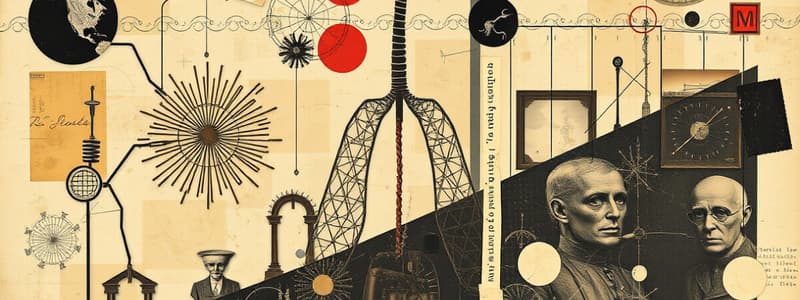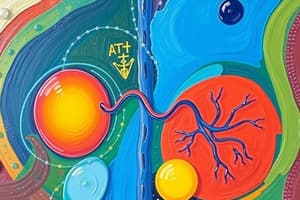Podcast
Questions and Answers
According to Model 1, what are the reactants of cellular respiration?
According to Model 1, what are the reactants of cellular respiration?
glucose and oxygen
According to Model 1, what are the products of cellular respiration?
According to Model 1, what are the products of cellular respiration?
carbon dioxide, water, energy
Which phase of cellular respiration occurs in the cytoplasm of the cell?
Which phase of cellular respiration occurs in the cytoplasm of the cell?
glycolysis
Which phases of cellular respiration occur in the mitochondria?
Which phases of cellular respiration occur in the mitochondria?
Which of the four phases of cellular respiration require oxygen?
Which of the four phases of cellular respiration require oxygen?
Which of the four phases of cellular respiration produce carbon dioxide?
Which of the four phases of cellular respiration produce carbon dioxide?
Which of the four phases of cellular respiration produce water?
Which of the four phases of cellular respiration produce water?
Which of the four phases of cellular respiration result in the production of ATP?
Which of the four phases of cellular respiration result in the production of ATP?
How many ATPs (total) are produced for every glucose molecule that undergoes cellular respiration?
How many ATPs (total) are produced for every glucose molecule that undergoes cellular respiration?
What reactants of ATP must be available in the cell in order to produce ATP?
What reactants of ATP must be available in the cell in order to produce ATP?
Brainstorm several cellular processes for which energy of ATP is necessary.
Brainstorm several cellular processes for which energy of ATP is necessary.
Consider Model 1. Besides ATP, what other molecules appear to be high potential energy molecules during cellular respiration?
Consider Model 1. Besides ATP, what other molecules appear to be high potential energy molecules during cellular respiration?
How many electrons are in a hydrogen ion (H+)?
How many electrons are in a hydrogen ion (H+)?
Is a hydrogen ion with its positive charge likely to be attracted to NAD+, FAD, or O2 without an input of free energy?
Is a hydrogen ion with its positive charge likely to be attracted to NAD+, FAD, or O2 without an input of free energy?
Can two positively charged particles combine to form a neutral particle?
Can two positively charged particles combine to form a neutral particle?
What is the charge on an electron?
What is the charge on an electron?
For each reaction, predict the number of electrons that must be involved in the reaction to make the charge balance.
For each reaction, predict the number of electrons that must be involved in the reaction to make the charge balance.
Are the reactions in Model 2 oxidation or reduction reactions?
Are the reactions in Model 2 oxidation or reduction reactions?
Which form of nicotinamide adenine dinucleotide is the 'reduced' form, NAD+ or NADH?
Which form of nicotinamide adenine dinucleotide is the 'reduced' form, NAD+ or NADH?
Is glucose being oxidized or reduced during cellular respiration?
Is glucose being oxidized or reduced during cellular respiration?
Validate your answer by comparing the ratio of carbon atoms to oxygen atoms in the chemical formulas of glucose versus carbon dioxide.
Validate your answer by comparing the ratio of carbon atoms to oxygen atoms in the chemical formulas of glucose versus carbon dioxide.
What reactants must be available in the cell to make NADH be produced?
What reactants must be available in the cell to make NADH be produced?
What molecules are produced as the hydrogen ions and electrons are removed from NADH and FADH2?
What molecules are produced as the hydrogen ions and electrons are removed from NADH and FADH2?
Is the removal of hydrogen ions and electrons from NADH and FADH2 oxidation or reduction?
Is the removal of hydrogen ions and electrons from NADH and FADH2 oxidation or reduction?
Predict what happens to those product molecules after they 'drop off' their hydrogen ions and electrons.
Predict what happens to those product molecules after they 'drop off' their hydrogen ions and electrons.
Predict the number of ATP molecules that could be produced from one glucose molecule if oxygen were not available.
Predict the number of ATP molecules that could be produced from one glucose molecule if oxygen were not available.
Since oxidative phosphorylation no longer occurs when oxygen is not available, predict what would happen to the supply of NAD+ in the cell if only glycolysis were occurring.
Since oxidative phosphorylation no longer occurs when oxygen is not available, predict what would happen to the supply of NAD+ in the cell if only glycolysis were occurring.
Flashcards are hidden until you start studying
Study Notes
Overview of Cellular Respiration
- Reactants of cellular respiration: glucose and oxygen
- Products of cellular respiration: carbon dioxide, water, energy (ATP)
Phases of Cellular Respiration
- Glycolysis occurs in the cytoplasm
- Phases in mitochondria: link reaction, Krebs cycle, oxidative phosphorylation
- Oxidative phosphorylation requires oxygen
- Carbon dioxide is produced during link reaction and Krebs cycle
- Water is produced during oxidative phosphorylation
- ATP is produced in glycolysis, Krebs cycle, and oxidative phosphorylation
Energy Production
- Total of 38 ATP produced from one glucose molecule during respiration
- Reactants necessary for ATP production: ADP and inorganic phosphate (Pi)
- ATP is essential for processes like muscle contraction, protein synthesis, and cell division
High Energy Molecules
- High potential energy carriers during cellular respiration: NADH and FADH2
- A hydrogen ion (H+) has no electrons
- Hydrogen ions are attracted to negatively charged ions, not to NAD+, FAD, or O2
- Two positively charged particles cannot form a neutral particle
Electron Dynamics
- An electron carries a charge of -1
- Each reaction requires two electrons to balance charge
- Model 2 reactions are reduction reactions, involving the gain of electrons
- NADH is the "reduced" form of nicotinamide adenine dinucleotide
Oxidation and Reduction
- Glucose is oxidized during cellular respiration as it donates electrons to NAD+ and FAD
- Carbon atoms to oxygen atoms ratio:
- Glucose (C6H12O6) ratio: 1C:1O
- Carbon dioxide (CO2) ratio: 1C:2O
- More oxygen per carbon indicates a more oxidized form
NAD+ and FAD Redox States
- Necessary reactants for NADH production: NAD+ and H+
- Removal of hydrogen ions and electrons converts NADH and FADH2 back to NAD+ and FAD
- This removal process is an oxidation reaction
Recycling and Cellular Conditions
- After hydrogen removal, NAD+ and FAD can be recycled in glycolysis, link reaction, and Krebs cycle
- In absence of oxygen, only 2 ATP are produced from one glucose molecule
- If only glycolysis occurs without oxygen, NAD+ supply depletes, halting glycolysis eventually.
Studying That Suits You
Use AI to generate personalized quizzes and flashcards to suit your learning preferences.




